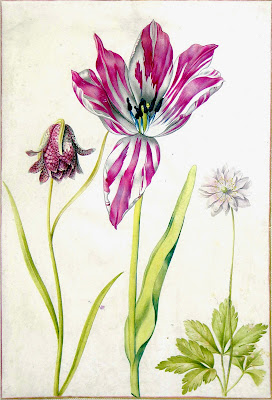Offering of the Day: A Masterpiece of Dutch Seventeenth-Century Flower Painting
Dutch School (early seventeenth-century)
Double Snake’s Head Fritillary, Hybrid of Persian Tulip, and a double Wood Anemone
Pen and grey ink, watercolor on prepared vellum with gold, red ink framing lines
Paper size: 12” x 8 1/2”
Frame size: 22” x 18 1/8”
Unidentified collectors number verso: No. 197
Provenance: Dutch private collection
$85,000.
This stunning watercolor is by a seventeenth-century Dutch master of some note* as can be clearly judged by the skillful and immaculately rendered detail of each of these beautiful flowers. Although the authorship remains uncertain, it is clear that the painter of this work was familiar with French developments in flower painting and most particularly the Velins du Roi to which Nicholas Robert (1614-1685) was a major contributor, his influence clearly visible here. The watercolors Robert completed under Gaston d'Orleans and then Louis XIV for the royal collection fed the interest and provided the inspiration for the great masters of botanical and ornithological art who followed and the author of this particular painting can be considered among them.
The specimens shown, kindly identified by Dr. Sam Segal, are the Double Snake’s Head Fritillary which is found all over Europe; the double Wood Anemone found in Europe to East-Asia and Northern America; and the hybrid of a Persian tulip originating from Iraq-Iran. The tulip was first introduced to Europe in 1552 by Charles Lecluse who bought seeds from Otto de Busbecq, the Austrian Ambassador to Turkey. The first recorded sighting of a tulip in Western Europe was not until 1559, when the Zurich physician and botanist Conrad Gesner saw it flowering for the first time in the garden of Johannis Heinrich Herwart of Augsburg, Bavaria. With the establishment of the Dutch East India Company, the flower soon became an import into Amsterdam’s growing port and Lyclen became the main center of cultivation. The unpredicatable nature of the tulip’s flowering, when some blooms would inexplicably ‘break’, causing the petals to display ‘feathered’ or ‘flamed’ patterns, as seen here, is the most probably reason for the bulbs remarkable popularity and the so-called tulipomania of 1634 to 1637. Speculation drove the market for them with traders and wealthy collectors paying thousands of guilders for exotic specimens, especially the ‘broken’ tulips with unusual markings.
The art of tulip illustration reached its height in the Low Countries during this period. As the demand for tulip blooms blossomed, bulb dealers and wealthy burghers employed artists to paint likenesses of their precious flowers. Single tulip flowers were most often shown in tulip albums, a sort of retail catalogue for bulb dealers. It is likely that this particular watercolor on vellum was for a private collector who wished to record the flowers in his garden. With the price of tulip bulbs being so high and their flowering season so short, collectors were keen to record their specimens as a means of displaying wealth, but also to admire in their own homes. The indications for this conclusion are as follows: the work is on vellum not paper, a more expensive material to paint on, thus indicating a more highly prized piece; in the same vein, the quality and skill of the work, displayed within gold framing lines, reflects its value; and finally, although the tulip is displayed most prominently, other flowers are shown, perhaps showing the other specimens blooming in one individual collector’s garden.
* While clearly dating from the early seventeenth century, it has not been possible to attribute this refined drawing to a known artist with certainty. It has also been suggested that, being reminiscent of the work of Georg Flegel, this could be by a seventeenth-century German hand.



Comments
Post a Comment